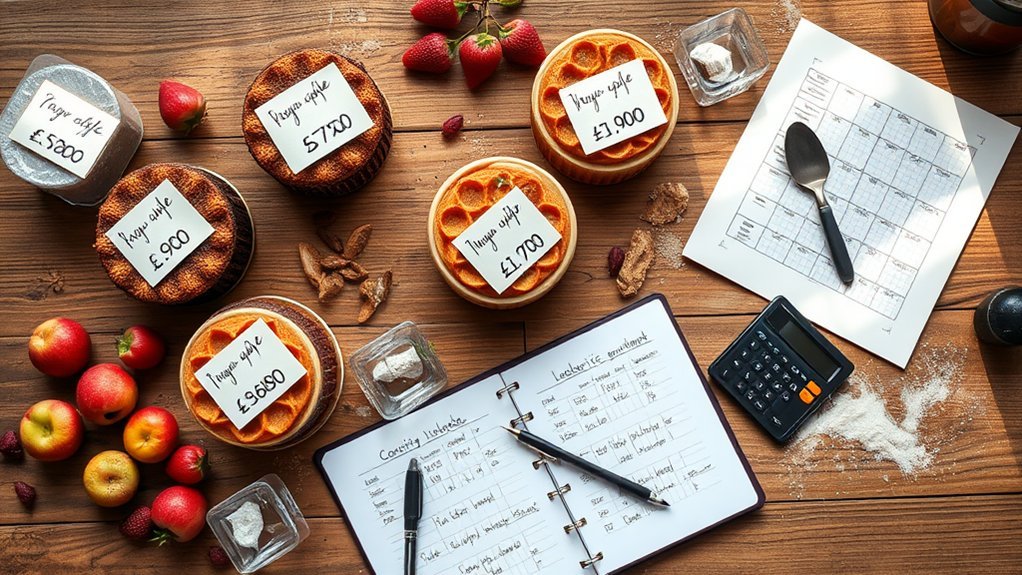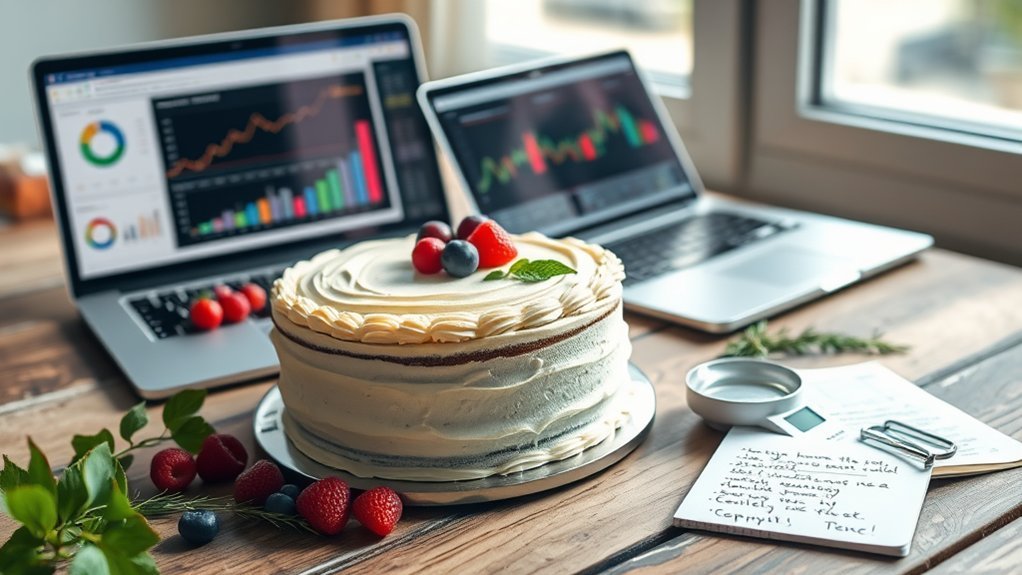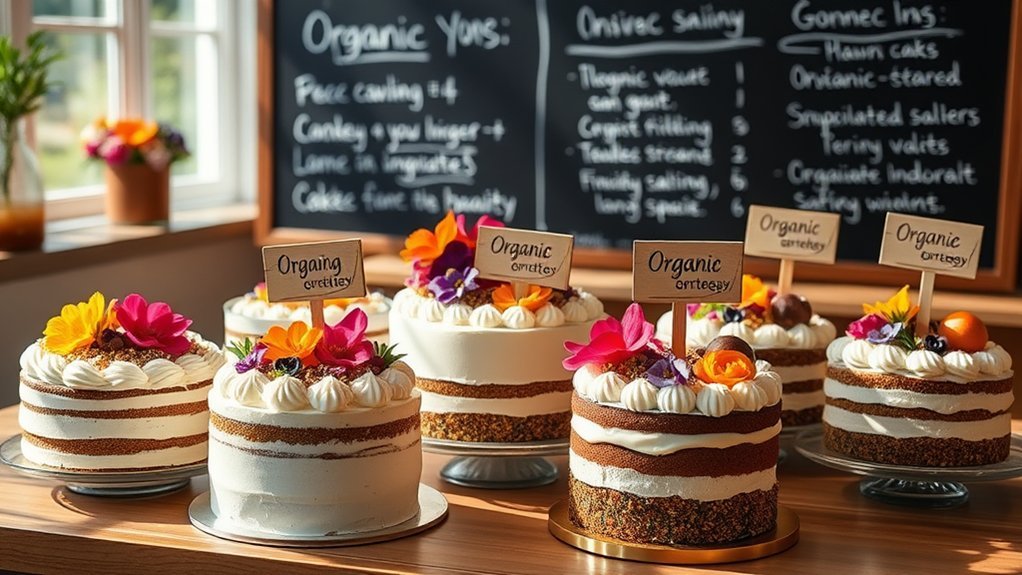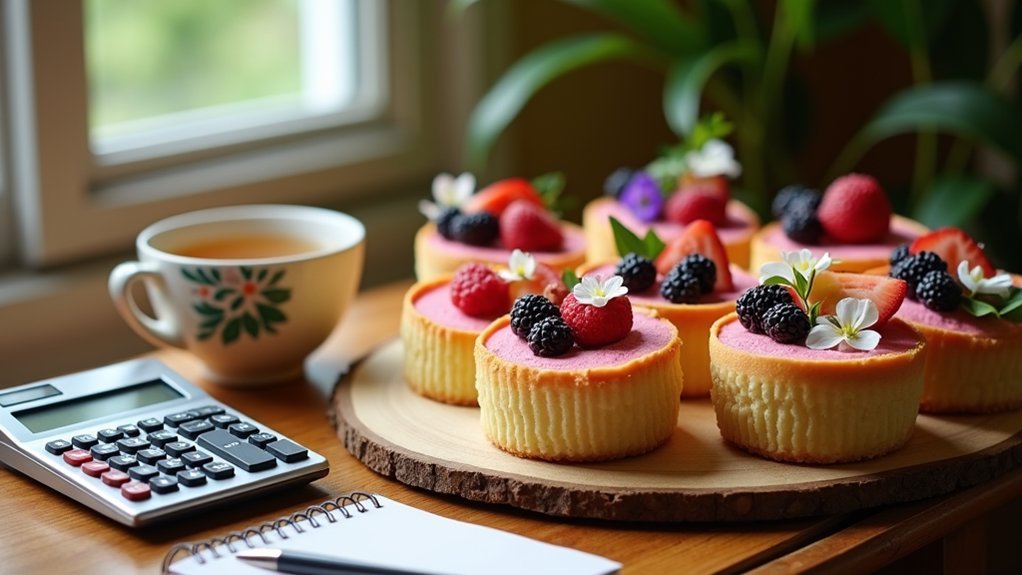How to Price Your Organic Cakes for Profit
To price your organic cakes for profit, start by calculating all costs, including ingredients, labour, and overheads. Aim for a profit margin of around 20% to ensure sustainability. Assess market demand and highlight unique features of your cakes that offer added value. Consider using psychological pricing strategies, such as charm pricing (e.g., £4.99 instead of £5) or prestige pricing (pricing higher to suggest quality), to attract customers. By applying effective pricing techniques, you can ensure profitability while appealing to health-conscious buyers. There’s plenty more to discover about optimising your pricing strategy.
Key Takeaways
- Calculate your total costs, including ingredients, labour, and overheads, to establish a baseline for pricing your organic cakes.
- Aim for a profit margin of around 20% to ensure your pricing is sustainable.
- Emphasise unique ingredients and artisanal techniques to justify higher prices and attract health-conscious buyers.
- Use psychological pricing strategies, such as ending prices in .99 or setting premium prices, to enhance perceived value and encourage sales.
- Keep an eye on market trends and adjust your prices seasonally to stay competitive and maximise profit.
Understanding Your Costs

Understanding your costs is crucial for pricing organic cakes appropriately and ensuring profitability. Start with sourcing ingredients; organic components usually cost between £10 and £15 for an 8-inch cake, significantly more expensive than conventional alternatives. This cost can rise with additional fillings and decorations, so consider buying locally or in bulk to help reduce expenses. Additionally, sustainable sourcing practices can enhance your product appeal and support your pricing strategy.
Next, examine your labour costs, which can vary, especially with intricate designs. Average hourly wage for bakers and decorators can significantly impact your overall expense, so streamlining your production process can help lower these costs while maintaining quality and improving efficiency. Tracking time spent on orders can also inform better pricing strategies over time.
Don’t overlook overhead costs like rent and utilities, as these are vital to your pricing strategy. By carefully assessing these factors, you can set competitive prices that reflect your dedication to quality and sustainability.
Analyzing the Market

When pricing organic cakes, it’s crucial to analyse the market to create a competitive strategy. Understanding market trends and consumer preferences allows you to tailor your products effectively. With the global organic bakery market set for significant growth, targeting health-conscious consumers is key. They often prefer clean-label, non-GMO, and plant-based options. Additionally, the U.S. organic cake market is projected to grow at a CAGR of 8.5% (2021-2026), highlighting the lucrative potential of this segment. The increasing consumer awareness about the health benefits linked to organic ingredients further supports the demand for your products.
| Key Trends | Insights |
|---|---|
| Demand for Organic | Health and environmental concerns shape choices. |
| E-commerce Growth | Increases accessibility to organic products. |
| Sustainable Practices | Aligns with consumer desires for transparency. |
Establishing Your Profit Margin

To establish a solid profit margin for your organic cakes, it’s crucial to accurately calculate your total costs, including ingredients, labour, and overhead.
Begin by meticulously tracking every expense—this covers the organic materials, the time spent baking and decorating, as well as overhead costs like utilities and marketing. Aim for a profit margin of around 20%, and adjust your selling prices accordingly. Accurate costing is essential for determining profitable price points, ensuring that all your expenses are covered while still allowing for a reasonable profit margin. Consider factors like market conditions and seasonal ingredient changes, which can impact your costs and what customers are willing to pay. Additionally, sourcing ingredients seasonally can significantly enhance flavour and further influence your pricing strategy.
Using cost-tracking software can improve accuracy and help you avoid underpricing. By paying attention to these elements, you’ll set up your bakery for consistent profitability while providing high-quality products to your customers.
Leveraging Unique Features for Value-Based Pricing

By emphasising the unique features of your organic cakes, you can implement value-based pricing that appeals to your target audience.
Showcasing distinctive ingredients sets your cakes apart and justifies a higher price, as customers often appreciate quality and uniqueness.
Utilising artisanal production methods boosts perceived value, attracting consumers who value craftsmanship and sustainability.
Conducting market research will help you gauge how these unique aspects influence customer willingness to pay.
By positioning your cakes as health-conscious and eco-friendly, you tap into current consumer trends.
Ultimately, sharing stories about these unique features and presenting your cakes attractively creates a stronger connection with your audience, encouraging them to invest in the quality you offer.
Implementing Psychological Pricing Strategies

Psychological pricing strategies can significantly boost your cake sales by aligning prices with how consumers think and behave. Using charm pricing, for instance, you can price your cakes at £9.99, making them seem more affordable. Prestige pricing, on the other hand, positions high-quality cakes as luxury items, appealing to customers willing to pay a premium. Price anchoring works by showing a higher-priced cake first, making the subsequent prices seem more reasonable.
| Strategy | Description |
|---|---|
| Charm Pricing | Prices set just below a round number (e.g., £4.99) |
| Prestige Pricing | High prices suggest luxury and exclusivity |
| Price Anchoring | Presenting higher prices first for comparison |
| Limited Editions | Creates urgency and boosts demand |
| Seasonal Pricing | Adjust prices based on demand fluctuations |
Understanding consumer psychology ensures your pricing resonates effectively with your audience.
Frequently Asked Questions
How Do I Handle Pricing for Custom Cake Orders?
When setting prices for custom cake orders, take into account the cost of ingredients, labour, and overheads. For example, if a cake requires premium chocolate and fresh fruit, factor in these higher material costs. Establish a pricing strategy that balances these expenses with what customers are willing to pay, ensuring you remain profitable while meeting client expectations.
What Should I Include in My Overhead Cost Calculations?
When calculating overhead costs, be sure to factor in ingredient expenses, staff wages, rent, utilities, and insurance. It’s crucial to regularly monitor these costs to ensure you’re accurately representing your total expenses. This will help you price your cakes appropriately and maintain a sustainable business. For example, if you’re paying £500 a month in rent and £200 for utilities, that adds up to a significant portion of your overall costs.
How Can I Effectively Communicate Value to Customers?
To communicate value effectively, start with a clear value proposition that highlights quality and craftsmanship. Educate your customers about the benefits of your organic cakes by being transparent about ingredient sourcing. Use relatable examples, such as how your cakes are made with locally sourced ingredients, to help them appreciate their unique qualities. Engaging content can further connect with customers and enhance their understanding of what sets your products apart.
Should I Offer Bulk Discounts for Large Orders?
Offering bulk discounts can boost customer loyalty and bring considerable advantages for large orders. By encouraging bigger purchases, you strengthen relationships and potentially increase your overall revenue. For instance, if a local café orders supplies in larger quantities, they might benefit from a discount, enabling them to save costs and manage their budget more effectively. This approach also helps you maintain profit margins and manage your inventory, supporting long-term growth.
How Often Should I Review My Pricing Strategy?
You should review your pricing strategy every month, taking into account market trends and competitor analysis. This ensures you can quickly adapt to changes, optimise profitability, and meet customer needs while keeping a competitive edge. For example, if a competitor lowers their prices, you may need to assess whether to adjust yours accordingly to remain appealing to your customers.
Conclusion
In summary, pricing your organic cakes requires more than just covering your costs; it’s a strategic process. Start by calculating your expenses, studying market prices, and setting a reasonable profit margin. For example, if your cake costs £5 to make, consider pricing it at £10 to ensure a good profit while remaining competitive. Use psychological pricing techniques, like pricing your cake at £9.99 instead of £10, to attract customers’ attention. By implementing these strategies, you can achieve profitability while connecting with your customers, ensuring your cakes are both loved and lucrative.







